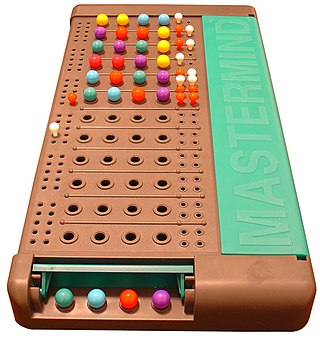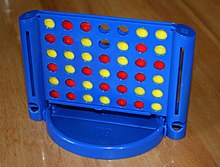
Sternhalma, commonly known as Chinese checkers or Chinese chequers, is a strategy board game of German origin that can be played by two, three, four, or six people, playing individually or with partners. The game is a modern and simplified variation of the game Halma.

Reversi is a strategy board game for two players, played on an 8×8 uncheckered board. It was invented in 1883. Othello, a variant with a fixed initial setup of the board, was patented in 1971.

Tic-tac-toe, noughts and crosses, or Xs and Os is a paper-and-pencil game for two players who take turns marking the spaces in a three-by-three grid with X or O. The player who succeeds in placing three of their marks in a horizontal, vertical, or diagonal row is the winner. It is a solved game, with a forced draw assuming best play from both players.

Checkers, also known as draughts, is a group of strategy board games for two players which involve forward movements of uniform game pieces and mandatory captures by jumping over opponent pieces. Checkers is developed from alquerque. The term "checkers" derives from the checkered board which the game is played on, whereas "draughts" derives from the verb "to draw" or "to move".

Mastermind or Master Mind is a code-breaking game for two players invented in Israel. It resembles an earlier pencil and paper game called Bulls and Cows that may date back a century.

TwixT is a two-player strategy board game, an early entrant in the 1960s 3M bookshelf game series. It became one of the most popular and enduring games in the series. It is a connection game where players alternate turns placing pegs and links on a pegboard in an attempt to link their opposite sides. While TwixT itself is simple, the game also requires strategy, so young children can play it, but it also appeals to adults. The game has been discontinued except in Germany and Japan.

Battleship is a strategy type guessing game for two players. It is played on ruled grids on which each player's fleet of warships are marked. The locations of the fleets are concealed from the other player. Players alternate turns calling "shots" at the other player's ships, and the objective of the game is to destroy the opposing player's fleet.

Parcheesi is a brand-name American adaptation of the Indian cross and circle board game Pachisi, published by Selchow & Righter and Winning Moves Games USA.
The Shannon switching game is a connection game for two players, invented by American mathematician and electrical engineer Claude Shannon, the "father of information theory" some time before 1951. Two players take turns coloring the edges of an arbitrary graph. One player has the goal of connecting two distinguished vertices by a path of edges of their color. The other player aims to prevent this by using their color instead. The game is commonly played on a rectangular grid; this special case of the game was independently invented by American mathematician David Gale in the late 1950s and is known as Gale or Bridg-It.

Teeko is an abstract strategy game invented by John Scarne in 1937 and rereleased in refined form in 1952 and again in the 1960s. Teeko was marketed by Scarne's company, John Scarne Games Inc.; its quirky name, he said, borrowed letters from Tic-tac-toe, Chess, Checkers, and Bingo.

Chapayev is a board game, a hybrid of checkers (draughts) and gamepiece-impact games like carrom, novuss, and pichenotte, giving it gameplay aspects in common with both billiards and table shuffleboard on a smaller scale, as well as some checkers strategy. It is played throughout the territory of the former USSR. The aim is to knock the opponent's pieces off the board. The game is named after the Russian Civil War hero, Vasily Chapayev.

English draughts or checkers, also called straight checkers or simply draughts, is a form of the strategy board game checkers. It is played on an 8×8 checkerboard with 12 pieces per side. The pieces move and capture diagonally forward, until they reach the opposite end of the board, when they are crowned and can thereafter move and capture both backward and forward.

Rubik's Games is a, five games in one, PC game created for Windows 95/98 developed in part by Ernő Rubik with Androsoft and was published by Hasbro Interactive. It was part of Hasbro's classical games collection of PC related games, translating their most famous board games into best possible quality video games. A history of the Rubik's Cube and its inventor, written out in a webpage type file, with pictures is available from the Menu.
Pasang is a two-player abstract strategy board game from Brunei. The game is often referred to as Pasang Emas which is actually a software implementation of the traditional board game. The object of this game is to acquire the most points by capturing black and white tokens on the board. Black tokens are worth 1 point, and white tokens are worth 2 points. The board is initially laid out with all 120 black and white tokens in one of over 30 traditional patterns. Players choose a piece called a "ka" which is used to capture the tokens on the board. Each player's "ka" moves around the board capturing as many tokens as possible. As a note, the "kas" are the only mobile pieces in the game. The other pieces are stationary, and are captured by the "kas". Players must capture token(s) during their turn, or lose the game. When all tokens have been captured from the board, the player with the most points is the winner. However, if there are any tokens left on the board, and none can be captured on a player's turn, then that player loses the game, and the other player is the winner.

Zillions of Games is a commercial general game playing system developed by Jeff Mallett and Mark Lefler in 1998. The game rules are specified with S-expressions, Zillions rule language. It was designed to handle mostly abstract strategy board games or puzzles. After parsing the rules of the game, the system's artificial intelligence can automatically play one or more players. It treats puzzles as solitaire games and its AI can be used to solve them.
Cinc camins is a two-player abstract strategy game from northern China. Although played by children, there is a complexity and uniqueness to the game that adults can appreciate. The game may be related to the gonu (kono) games of Korea. These games use small boards, and have unique capturing rules.
Brax is a two-player abstract strategy board game. It was invented in 1889 in America by Frederic B. Denham of New York City. The board design is unique. The players move their pieces along paths on the square board; each path is one of two colors. A piece can move one or two spaces in a turn depending upon whether it matches the color of the path. Players attempt to capture each other's pieces.

Battleship/Connect Four/Sorry!/Trouble is a compilation video game developed by British studio Gravity-I and published by DSI Games. It was released for Nintendo DS in North America on August 17, 2006 and is the fifth of six compilation video games of Hasbro board games developed by Gravity-I and released on Nintendo handhelds. The game contains versions of four board games from Milton Bradley and Parker Brothers, which are both Hasbro brands. A sequel, titled Clue/Mouse Trap/Perfection/Aggravation, was released the following year, adapting four more Hasbro board games in a single cartridge: Clue, Mouse Trap, Perfection and Aggravation.
Connect 4x4 is a three-dimensional-thinking strategy game first released in 2009 by Milton Bradley. The goal of the game is identical to that of its similarly named predecessor, Connect Four. Players take turns placing game pieces in the grid-like, vertically suspended playing field until one player has four of his or her color lined up horizontally, vertically, or diagonally. Unlike its predecessor, Connect 4x4 uses a double grid, two different types of game pieces, and can be played by up to four people at once.
This glossary of board games explains commonly used terms in board games, in alphabetical order. For a list of board games, see List of board games; for terms specific to chess, see Glossary of chess; for terms specific to chess problems, see Glossary of chess problems.

















